Product-led growth is a business approach that emphasizes leveraging your product as the primary means to attract, engage, and keep customers.
In the conventional growth model for enterprise software-as-a-service (SaaS) companies, potential customers are not allowed to try the product.
Instead, they may be required to schedule a demonstration with a sales representative, sign a contract, and make a payment before gaining access to the product.
This sales-led approach often leads to customers needing help with the product, as they have already made a financial commitment, which can be attributed to loss aversion.
A product-led growth model offers an alternative to traditional sales-led growth and enables companies to provide value to customers quickly.
According to research by Bain & Company, product-led growth leads to expansion revenue, a larger market share, and higher third-party investment.
By the end of this article, you will understand:
- What product-led growth is, and why it is important
- Why product-led growth is the future of SaaS
- The difference between a sales-led and a product-led approach
- The benefits of product led growth and its most important metrics
- What a product-led company looks like from those who have used it successfully
- How to become product-led and put this type of growth strategy in place
- The next steps of product-led growth
What Is Product Led Growth (PLG)?
Product-led growth is a sustainable business strategy that relies on utilizing the product as the primary driver to acquire, activate, and retain customers.
In these instances, there is no need to request a demonstration from a front sales team or marketing representative, which is common with a sales-led approach.
Unlike sales-led companies, a product-led model allows users to freely try out the product through a freemium version or a free trial and discover its benefits on their own.
Why Is Product Led Growth Important?
Product-led growth offers companies a solution to scaling and growing efficiently by automating key onboarding, support, sales, and marketing functions.
Consequently, within a product-led company, staff can focus on more strategic and meaningful tasks while ensuring customers receive the necessary support and information.
In this way, product led growth should be viewed as a complement to human support and ingenuity rather than a replacement for it.
What Are The Benefits Of Product Led Growth?
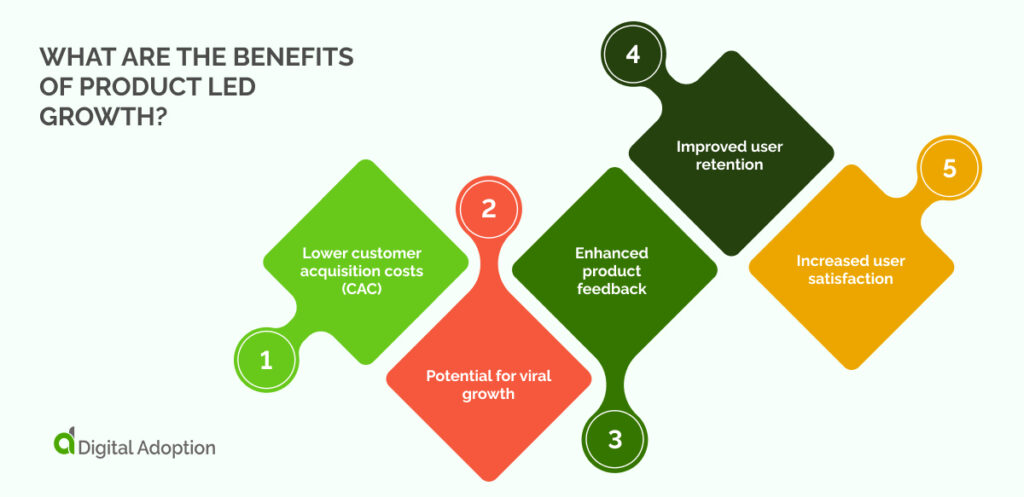
By placing more importance on product quality and user experience, a product-led revenue growth model offers numerous advantages, including:
Lower customer acquisition costs (CAC)
Companies that adopt a product-led growth approach can minimize their expenditure on sales, advertising, and marketing. Instead, the product gains traction through word-of-mouth, attracting new users through free or low-cost options and gradually transitioning them to more premium offerings.
Potential for viral growth
Product-focused companies tend to go to market and develop market-leading products. When users are enthusiastic about a product, they share their positive experiences with their networks, increasing the likelihood of the product going viral.
Enhanced product feedback
Placing the product at the core of your strategy allows for a more extensive collection of user feedback, as listening to and understanding the user experience is crucial.
This type of feedback can also help companies observe how users interact with their products, identifying value areas and potential problems and pain points. This persistent emphasis on user data enables the product-led team to make informed decisions on resource allocation for continuous product improvement.
Improved user retention
Customers will stop using a product if it does not meet their expectations. However, product-led companies strive to create intuitive products that effectively address real problems. By prioritizing the product, these companies achieve higher user retention rates.
Increased user satisfaction
By investing more resources in product development and feedback collection, companies with a product-led approach fine-tune their products to align with their intended audience’s requirements, leading to a better user experience.
Important Product Led Growth Metrics
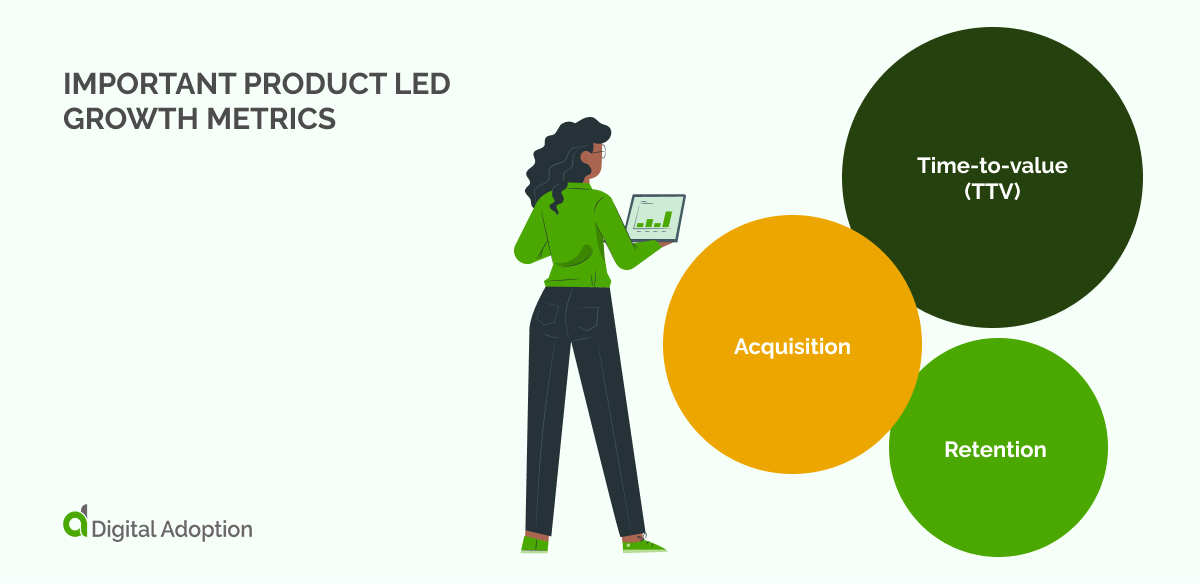
Product-led companies organize their teams around standard product metrics and success indicators to achieve alignment and a shared agenda. These metrics often overlap with those used in sales- and marketing-led environments, but product-led companies typically employ them for distinct purposes compared to these models.
Time-to-value (TTV)
The period between signing up and realizing the usefulness of a product is commonly referred to as time-to-value (TTV). TTV is determined by analyzing product data to ascertain the average duration it takes for a customer to reach a critical activation event. A primary objective for a product-led company is to minimize the TTV rate to the shortest possible timeframe for customer success.
Acquisition
Reducing Customer Acquisition Cost (CAC) is a fundamental aspect of product led growth (PLG) models. The ultimate objective for a company that adopts a product-led approach is to minimize CAC as much as possible.
During the initial stage of customer acquisition, it is essential to track key indicators such as signups and qualified leads to identify opportunities and challenges in lead generation.
Retention
A metric focused on customer retention involves observing the actions of existing customers who have remained loyal to the brand. You should also monitor your net revenue churn, which can signal potential issues that require attention.
Even if all freemium users are converted to paying customers, it is only relevant if they remain loyal.
Examples Of Product Led Companies
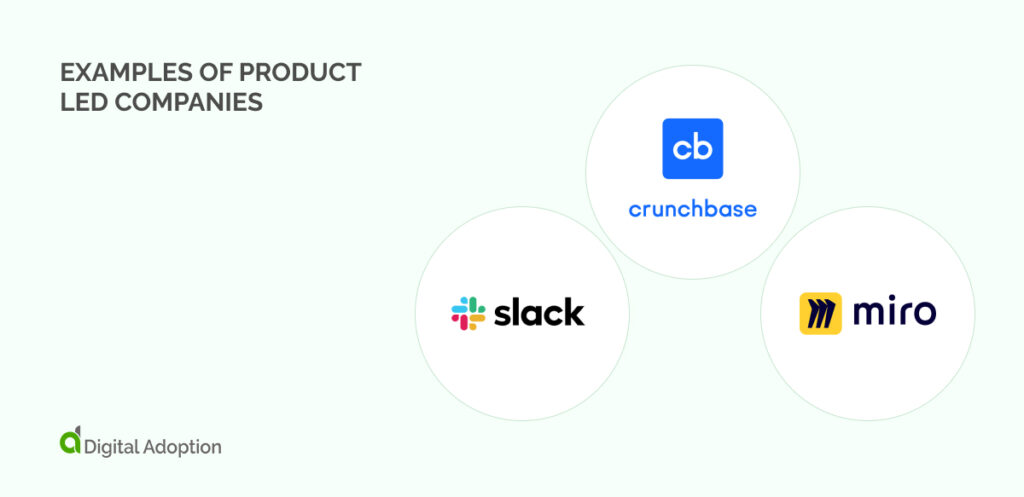
The most successful businesses in modern times have adopted the product-led growth strategy. These companies focus on building an exceptional product and letting it drive their marketing, sales, and customer success efforts.
To adopt a product-led approach, consider the following business examples:
Slack
Slack, an instant messaging application, was developed by sourcing copious amounts of user feedback, a crucial element of product-led growth.
When it launched in 2013, the founders initially requested companies within their network to test the application and provide constructive criticism. They diligently extracted feedback from as many early adopters as possible, progressively enhancing the product, its customer loyalty, its customer lifetime value, and its positioning.
Crunchbase
Crunchbase offers an easy initial sign-up process, requiring only your email, password, and an “I have an account” option.
However, the true highlight is when they ask how you intend to utilize the tool. This step allows you to tailor the platform to your specific interests.
Subsequently, the customer is presented with a personalized list of companies aligning with their unique preferences.
Miro
In contrast to other freemium or free trial models, Miro offers a free subscription that includes unlimited users, a valuable feature that encourages sign-ups.
Additionally, Miro boasts a collection of over 1,000 simple and user-friendly templates, facilitating quick and easy product utilization without friction, thereby delivering a seamless customer experience.
Furthermore, Miro enhances the template experience by tailoring it to individual users through seven onboarding questions.
This level of personalization is central to their customer-centric approach as it lowers the customer acquisition cost, expediting the product learning process and catering to each user’s unique requirements.
How To Put A Product Led Growth Strategy In Place
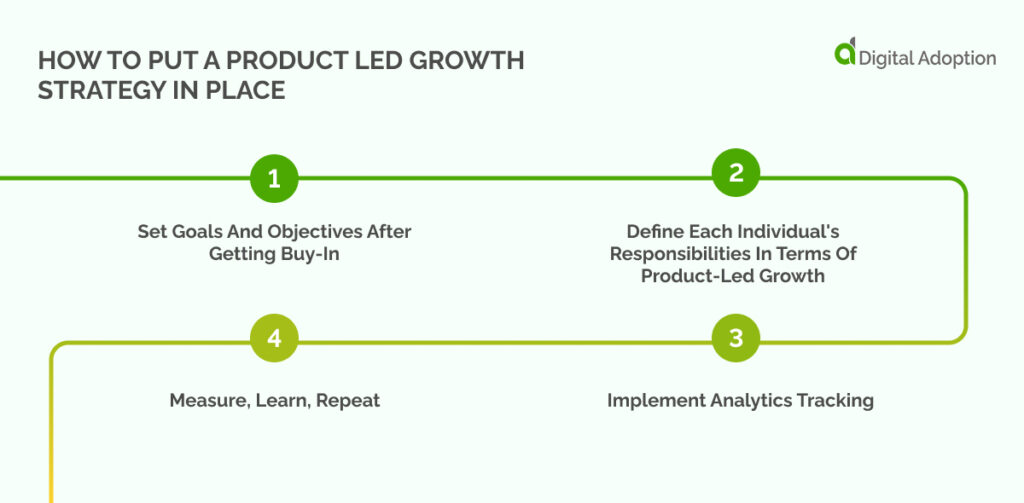
Product-led businesses focus on developing products that effectively communicate their value without requiring extensive sales efforts.
This is achieved through various elements, such as a seamless onboarding process, empowering end-users to explore the product independently, user-friendly interfaces and touchpoints, offering free trials and freemium services, and the potential for viral growth.
So, let’s look at how you can also put one in motion for your business:
Set Goals And Objectives After Getting Buy-In
Without the endorsement and support of robust and transformational leadership, it will be challenging to dedicate the necessary time, resources, and efforts towards enhancing the product, conducting experiments, and recruiting individuals who will contribute to the delivery of product-led growth.
Once the necessary buy-in has been obtained, you can start establishing specific objectives for product-led growth as part of your business strategy.
Define Each Individual’s Responsibilities In Terms Of Product-Led Growth
Product-led businesses need to establish clear ownership and accountability. Identify an individual or a team from within the organization who can take the lead in driving product led growth efforts.
This action ensures that several individuals within the business can work together towards this goal.
Product-led growth (PLG) enhances the tech buying process by using the product itself to drive customer acquisition, customer retention, and expansion. It focuses on delivering value through the product, leading to a heightened customer experience transformation.
Implement Analytics Tracking
To facilitate product led growth, it is of utmost importance to possess the necessary data for informed decision-making. This necessitates implementing digital tools to analyze user behavior and effectively lower customer acquisition costs.
Measure, Learn, Repeat
After you’ve run an initial experiment into the inner workings of your product, it is important to learn from it, whether it was positive or negative learnings. Gathering the entire team and allocating a few hours to review the experiment thoroughly is recommended.
The following techniques can be used to promote growth and improvement:
- Before the meeting, distribute a feedback form to the team, requesting their input on what went well, what did not, and what they learned from the experience.
- Encourage an open feedback session, like a Town Hall meeting, where all team members can contribute.
- Document all aspects of the experiment, utilizing a tool suitable for the team’s needs. For instance, Notion may be used to create a space where anyone can access and stay informed on the progress of the experiments. Visibility is crucial to product led growth (PLG).
- Incorporate the negative aspects of the experiment into the next one, utilizing them as a learning opportunity and ensuring that the same mistakes are not repeated.
Next Steps For Product Led Growth
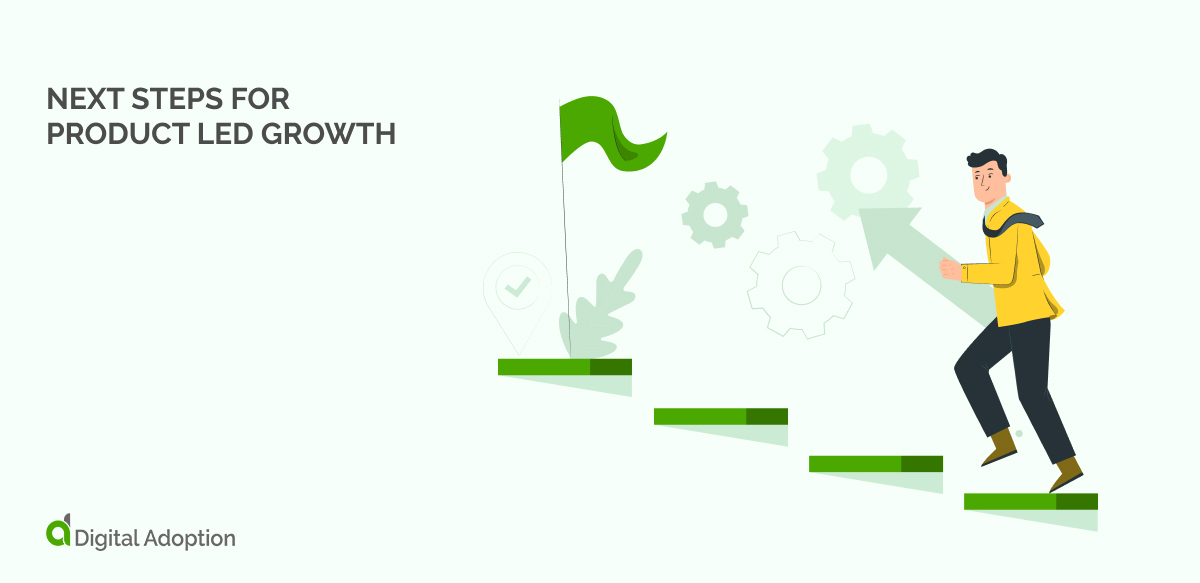
Product-led growth (PLG) is a strategic approach that focuses on developing a product with exceptional features, minimal obstacles, clear value, stickiness, and virality, all contributing to customer acquisition and retention.
With PLG, businesses can scale their operations with minimal additional costs or resources. Companies provide users with sufficient access to the product, such as key features or a trial period, to derive value from it, often before requiring them to provide their credit card details.
Additionally, all teams within the company prioritize the product, working together rather than independently. PLG companies also benefit from shorter sales cycles and receive a greater amount of user feedback, which aids in the development of superior products.
Furthermore, when putting a product-led growth strategy in place, you must set goals for your project after getting the go-ahead from leadership and decide on the contribution you need from each team involved in this product-led strategy.
Next, product-led organizations must experiment to improve and refine their product continuously.
Lastly, remember to continue to measure, learn, and repeat the steps of your product-led growth strategy to enhance the customer experience constantly.

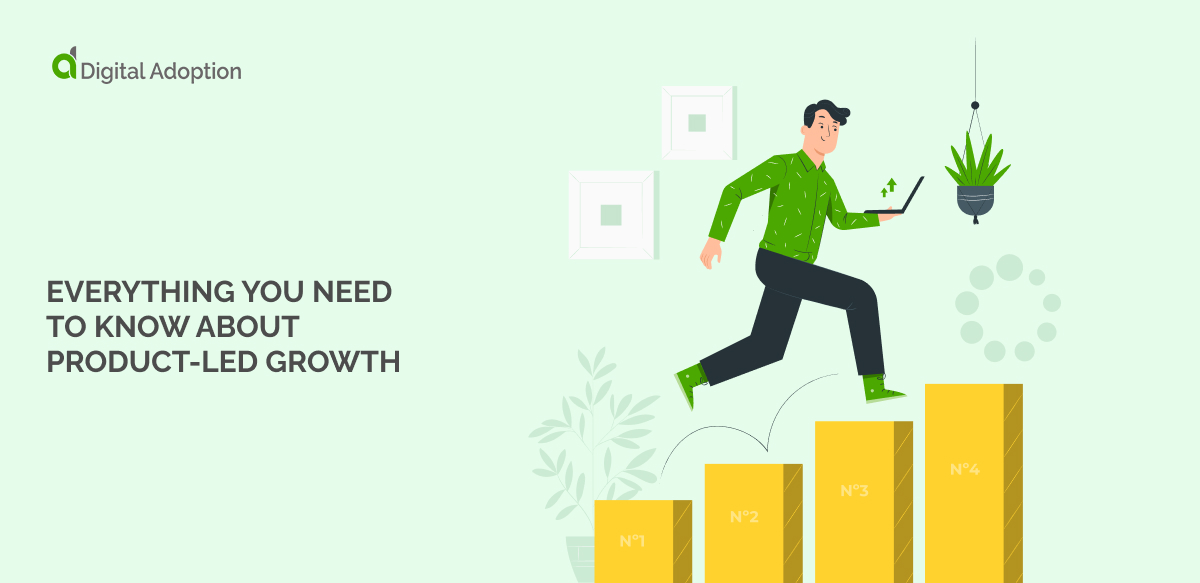


![18 Examples of AI in Finance [2025]](https://www.digital-adoption.com/wp-content/uploads/2025/06/18-Examples-of-AI-in-Finance-2025-300x146.jpg)
![14 Examples of AI in Manufacturing [2025]](https://www.digital-adoption.com/wp-content/uploads/2025/06/14-Examples-of-AI-in-Manufacturing-2025-300x146.jpg)
![29 Examples of AI in Education [2025]](https://www.digital-adoption.com/wp-content/uploads/2025/06/29-Examples-of-AI-in-Education-2025-300x146.jpg)
![15 Examples of AI in Retail [2025]](https://www.digital-adoption.com/wp-content/uploads/2025/06/15-Examples-of-AI-in-Retail-2025-300x146.jpg)
![13 Examples of AI in Healthcare [2025]](https://www.digital-adoption.com/wp-content/uploads/2025/06/AI-in-healthcare-examples-300x146.jpg)


![18 Examples of AI in Finance [2025]](https://www.digital-adoption.com/wp-content/uploads/2025/06/18-Examples-of-AI-in-Finance-2025.jpg)
![14 Examples of AI in Manufacturing [2025]](https://www.digital-adoption.com/wp-content/uploads/2025/06/14-Examples-of-AI-in-Manufacturing-2025.jpg)
![29 Examples of AI in Education [2025]](https://www.digital-adoption.com/wp-content/uploads/2025/06/29-Examples-of-AI-in-Education-2025.jpg)